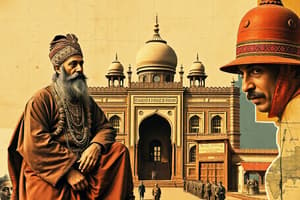Podcast
Questions and Answers
Who laid the foundation of the Mughal Empire?
Who laid the foundation of the Mughal Empire?
Babur
Which Mughal emperor is known for his architectural achievements, particularly the Taj Mahal?
Which Mughal emperor is known for his architectural achievements, particularly the Taj Mahal?
- Babur
- Jahangir
- Shah Jahan (correct)
- Akbar
Aurangzeb's policies contributed to the stability of the Mughal Empire.
Aurangzeb's policies contributed to the stability of the Mughal Empire.
False (B)
During which period did Akbar reign over the Mughal Empire?
During which period did Akbar reign over the Mughal Empire?
What was the major economic base of the Mughal Empire?
What was the major economic base of the Mughal Empire?
The language that developed during the Mughal Empire, blending Persian, Arabic, and local Indian languages is called ______.
The language that developed during the Mughal Empire, blending Persian, Arabic, and local Indian languages is called ______.
What was a significant factor contributing to the decline of the Mughal Empire?
What was a significant factor contributing to the decline of the Mughal Empire?
Which Mughal emperor faced significant challenges in consolidating control and was temporarily ousted from his empire?
Which Mughal emperor faced significant challenges in consolidating control and was temporarily ousted from his empire?
What lasting impact did the Mughal Empire have on Indian history?
What lasting impact did the Mughal Empire have on Indian history?
Flashcards
Mughal Empire
Mughal Empire
A significant historical empire in the Indian subcontinent, originating from the Timurid dynasty and lasting from the 16th to 18th centuries.
Babur
Babur
Founder of the Mughal Empire, establishing it through military conquests.
Akbar's Reign
Akbar's Reign
A period of significant Mughal expansion, administrative reforms, religious tolerance, and economic growth.
Aurangzeb
Aurangzeb
Signup and view all the flashcards
Taj Mahal
Taj Mahal
Signup and view all the flashcards
Mughal Administration
Mughal Administration
Signup and view all the flashcards
Economic system
Economic system
Signup and view all the flashcards
Decline of the Empire
Decline of the Empire
Signup and view all the flashcards
British Conquest
British Conquest
Signup and view all the flashcards
Mughal Legacy
Mughal Legacy
Signup and view all the flashcards
Study Notes
The Mughal Empire: Rise and Fall
- The Mughal Empire, a significant historical force in the Indian subcontinent, originated from the Timurid dynasty.
- Founded by Babur in 1526, it gradually expanded its control over vast territories, encompassing modern-day India, Pakistan, and parts of Afghanistan and Bangladesh.
- The empire's zenith was during the reigns of Akbar, Shah Jahan, and Aurangzeb, marked by significant cultural and administrative achievements.
Key Emperors and their Contributions
- Babur (1526-1530): Laid the foundation of the Mughal Empire through military conquests, establishing a new dynasty.
- Humayun (1530-1540, 1555-1556): Faced significant challenges in consolidating control and was briefly ousted from his empire, eventually regaining authority and preparing the groundwork for Akbar's reign.
- Akbar (1556-1605): Considered one of the greatest Mughal emperors, he is renowned for his administrative reforms, religious tolerance, and military expansions. He established a centralized administrative system and encouraged trade and economic growth.
- Jahangir (1605-1627): Continued the expansionist policies of his predecessors and commissioned various architectural projects. His reign witnessed significant advancements in art and culture.
- Shah Jahan (1628-1658): Famous for his architectural achievements, particularly the Taj Mahal. His reign also showed economic prosperity.
- Aurangzeb (1658-1707): Expanded the empire's territory but faced increasing opposition due to his religious policies, particularly his imposition of Islamic laws and persecution of non-Muslims which created significant conflicts that strained the empire. This period is marked by growing dissent and internal conflicts.
Administrative and Cultural Developments
- The Mughals established a sophisticated administrative system incorporating elements of Persian and Indian traditions.
- They maintained a strong military, contributing significantly to the empire's stability and growth.
- The Mughal court fostered patronage of the arts, resulting in magnificent architecture, painting, and literature. Examples include the Taj Mahal, Persian miniature paintings, and Urdu literature.
- The development of Urdu, a language blending Persian, Arabic, and local Indian languages, reflects the cultural synthesis of the period.
Economic Factors
- The Mughals established a robust economic system based on agriculture and trade.
- They encouraged internal and foreign trade, contributing to the empire's wealth and prosperity.
- The establishment of a well-organized revenue collection system played a critical role in the empire's economic strength.
- This system, while effective, also proved to be a source of conflict with local populations as it sometimes led to heavy taxation and resentment.
Decline of the Mughal Empire
- The later reigns of the Mughals saw gradual decline in their power and influence.
- Aurangzeb's aggressive expansionist policy and religious policies caused considerable instability and rebellion, straining the empire and creating deep-seated opposition. The heavy cost of maintaining a massive military, coupled with the widespread conflicts, gradually depleted the treasury.
- Regional powers began to assert autonomy, leading to fragmentation.
- The rise of the Marathas and other regional powers challenged Mughal authority and contributed to the gradual disintegration of the empire.
- The weakening of the Mughal administration and the increased power of regional forces ultimately led to the invasion of the British East India Company and Mughal demise.
- The eventual British conquest marked the end of the Mughal Empire.
Legacy
- The Mughal Empire left a significant mark on Indian history, influencing its art, architecture, culture, and administration.
- The legacy of the Mughals is still evident in numerous aspects of Indian society even today.
- Aspects of the Mughal Empire's administration and cultural trends are still witnessed in modern India, despite the end of the empire.
- The Taj Mahal and other architectural masterpieces remain prominent tourist attractions and symbols of India's rich heritage.
Studying That Suits You
Use AI to generate personalized quizzes and flashcards to suit your learning preferences.




